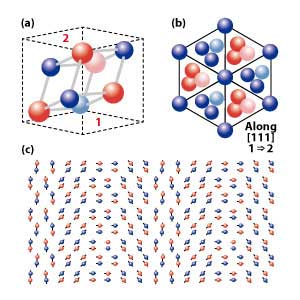| Posted: May 09, 2017 |
A new spin on data storage
(Nanowerk News) Tiny spirals of magnetism called skyrmions could be used as ultrahigh density energy-efficient data carriers.
|
|
Jarvis Loh, Gan Chee Kwan and Khoo Khoong Hong from the A*STAR Institute of High Performance Computing have modeled these minute spin spirals in nanoscopic crystal layers. They found that alternating layers of manganese silicide (MnSi) and cobalt silicide (CoSi) forms a promising material architecture (Journal of Magnetism and Magnetic Materials, "Helimagnetic order in bulk MnSi and CoSi/MnSi superlattices").
|
 |
| Two different views of manganese silicide are shown in (a) and (b), where the red and blue spheres represent manganese and silicon respectively. A larger scale view of manganese silicide showing spiraling atomic spins is shown in (c). (© Elsevier)
|
|
“Skyrmions are nanosized entities, only tens of nanometers, so they hold the promise of higher storage density than the current technology,” said Gan.
|
|
Storage based on skyrmions would represent binary data such as ‘1’s and ‘0’s as clockwise and anticlockwise spin spirals, respectively. Skyrmions can improve energy efficiency as they can be created and manipulated with currents significantly smaller than those required for conventional magnetic hard disk technology.
|
|
Skyrmions had been experimentally observed in manganese silicide, prompting the team to explore simulations of manganese silicide in its pristine form and in combination with similar materials.
|
|
The team selected cobalt silicide because cobalt sits close to manganese in the periodic table, and its similar lattice characteristics mean it should combine well with manganese silicide. Cobalt also has strong magnetic properties — it is ferromagnetic.
|
|
The team’s simulations showed that coupling cobalt silicide to manganese silicide enables the spin spirals in manganese silicide to be engineered. “What’s interesting is that we can now vary the size of skyrmions in an easy and elegant way,” Loh said.
|
|
In the skyrmion’s center the magnetic spin of the atoms is flipped 180 degrees relative to the spin on its outside edge; between the edge and the center the spins progressively tilt between the two extremes. Critical in the size of skyrmions is the ability of the material to support high relative tilt between neighboring atoms in the lattice, which enables the skyrmion to be packed into a smaller spiral.
|
|
The team found that adding cobalt silicide layers to the manganese silicide layers increased the possible relative tilt. However there is an upper limit — for cobalt silicide layers double the thickness of the manganese silicide, the material ceased to support skyrmions and transitioned to a more conventional ferromagnetic behavior.
|
|
One of the attractions of skyrmions as a data storage medium is their robustness, says Loh. “Unlike current magnetic storage, skyrmions are resistant to defects in the lattice. They are topologically protected.”
|
|
The team plans to apply their successful approach to other potential architectures, such as nanowires.
|

